2012 Peugeot 3008 Hybrid 4 headlamp
[x] Cancel search: headlampPage 4 of 284
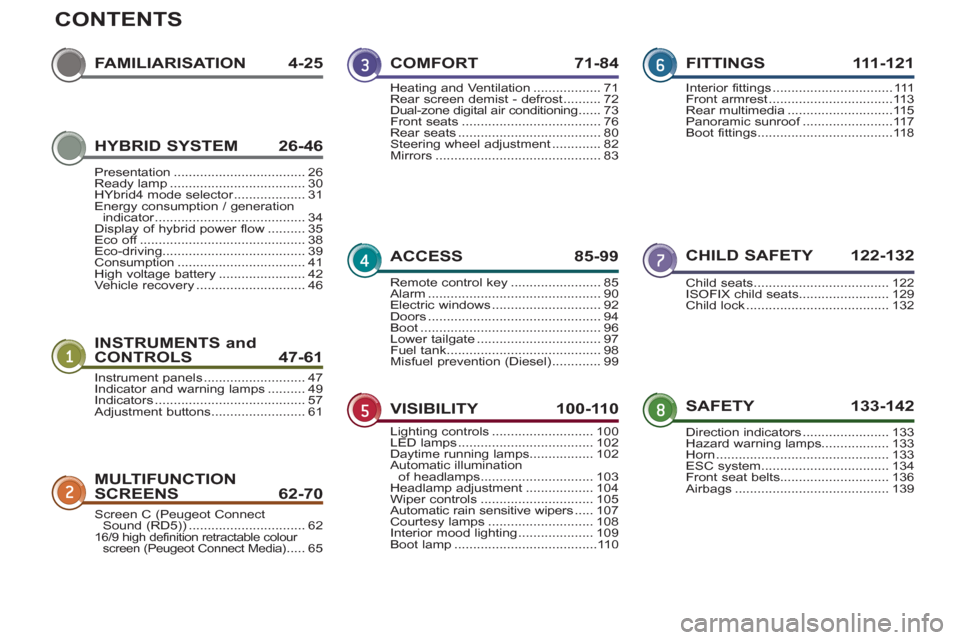
CONTENTS
FAMILIARISATION 4-25
IN
STRUMENTS and
CONTROLS 47-61
CHILD SAFETY 122-132
MULTIFUNCTION
SCREEN
S62-70
SAFETY 133-142 COMFORT 71-8
4
ACCESS 85-99
VISIBILITY 100-110FITTINGS 111-12
1
Instrument panels...........................47Indicator and warning lamps..........49Indicators........................................57Adjustment buttons.........................61
Child seats....................................122ISOFIX child seats........................129Child lock ......................................132
Screen C (Peugeot ConnectSound (RD5))...............................6216/9 high definition retractable colour
screen (Peugeot Connect Media).....65
Direction indicators.......................133Hazard warning lamps..................133Horn ..............................................133ESC system..................................134Front seat belts.............................136Airbags .........................................139
Heating and Ventilation ..................71Rear screen demist - defrost..........72Dual-zone digital air conditioning......73Front seats .....................................76Rear seats......................................80Steering wheel adjustment.............82Mirrors............................................83
Remote control key........................85Alarm ..............................................90Electric windows.............................92Doors..............................................94Boot................................................96Lower tailgate.................................97Fuel tank.........................................98Misfuel prevention (Diesel) .............99
Lighting controls...........................100LED lamps ....................................102Daytime running lamps.................102Automatic illumination
of headlamps..............................103Headlamp adjustment..................104Wiper controls ..............................105Automatic rain sensitive wipers .....107Courtesy lamps............................108Interior mood lighting....................109Boot lamp......................................110
Interior fittings................................111Front armrest.................................113Rear multimedia............................115Panoramic sunroof........................f117Boot fittings....................................118HYBRID SYSTEM 26-46
Presentation...................................26Ready lamp....................................30HYbrid4 mode selector...................r31Energy consumption / generationindicator........................................r34Display of hybrid power flow..........35Eco off............................................f38Eco-driving......................................39Consumption ..................................41High voltage battery.......................42Vehicle recovery.............................46
Page 12 of 284
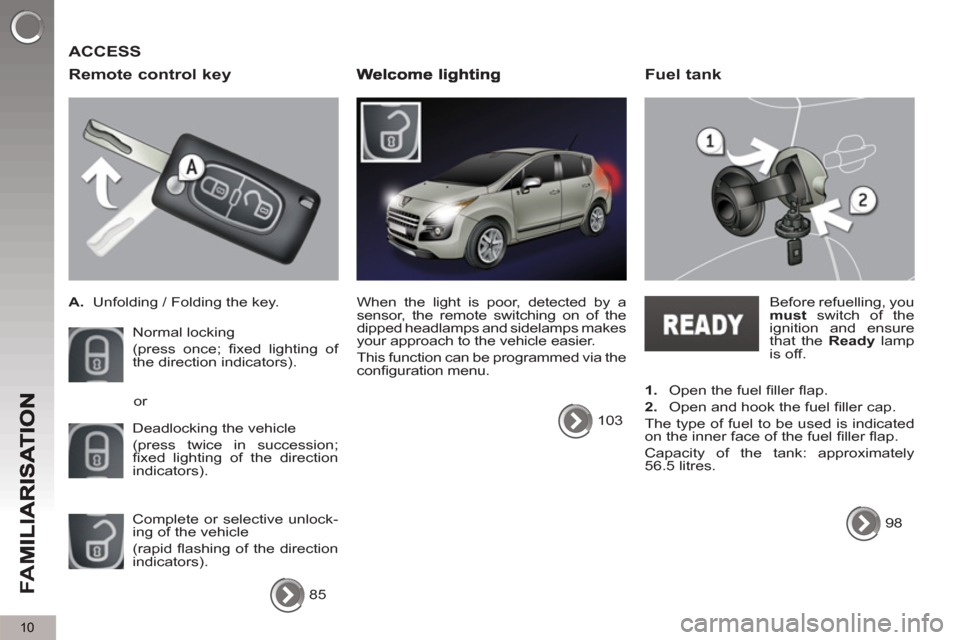
10
FA
M
ACCESS
Remote control ke
y
A.
Unfolding / Folding the key.
Normal locking
(press once; fi xed lighting of
the direction indicators).
Deadlocking the vehicle
(press twice in succession;
fi xed lighting of the direction
indicators).
Complete or selective unlock-
ing of the vehicle
(rapid fl ashing of the direction
indicators). or
85
When the light is poor, detected by a
sensor, the remote switching on of the
dipped headlamps and sidelamps makes
your approach to the vehicle easier.
This function can be programmed via the
confi guration menu.
103
98
Fuel tank
Before refuelling, you
must
switch of the
ignition and ensure
that the Ready
lamp
is off.
1.
Open the fuel fi ller fl ap.
2.
Open and hook the fuel fi ller cap.
The type of fuel to be used is indicated
on the inner face of the fuel fi ller fl ap.
Capacity of the tank: approximately
56.5 litres.
Page 16 of 284
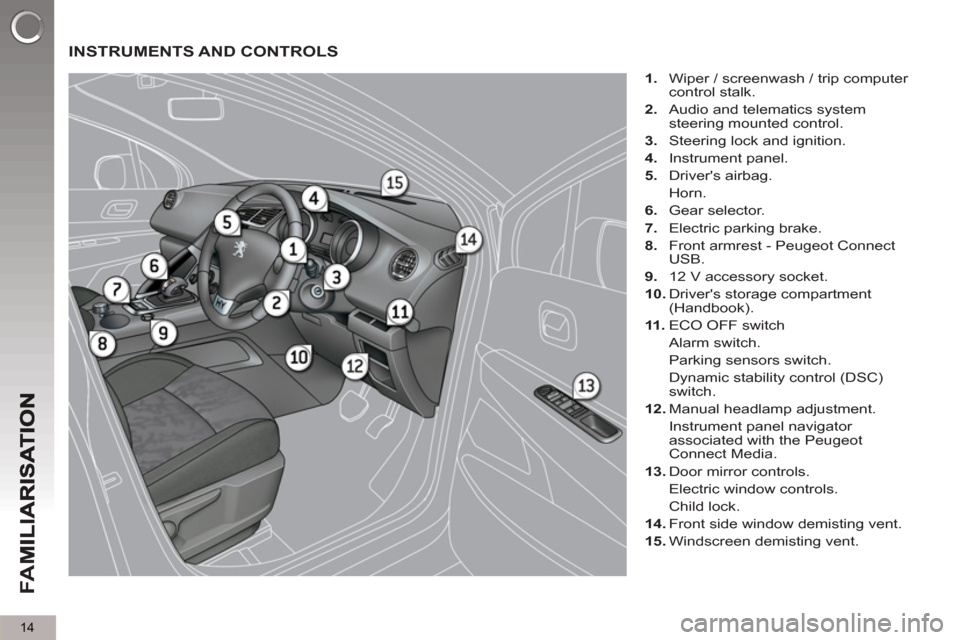
14
FA
M
INSTRUMENTS AND CONTROLS
1.
Wiper / screenwash / trip computer
control stalk.
2.
Audio and telematics system
steering mounted control.
3.
Steering lock and ignition.
4.
Instrument panel.
5.
Driver's airbag.
Horn.
6.
Gear selector.
7.
Electric parking brake.
8.
Front armrest - Peugeot Connect
USB.
9.
12 V accessory socket.
10.
Driver's storage compartment
(Handbook).
11 .
ECO OFF switch
Alarm switch.
Parking sensors switch.
Dynamic stability control (DSC)
switch.
12.
Manual headlamp adjustment.
Instrument panel navigator
associated with the Peugeot
Connect Media.
13.
Door mirror controls.
Electric window controls.
Child lock.
14.
Front side window demisting vent.
15.
Windscreen demisting vent.
Page 20 of 284
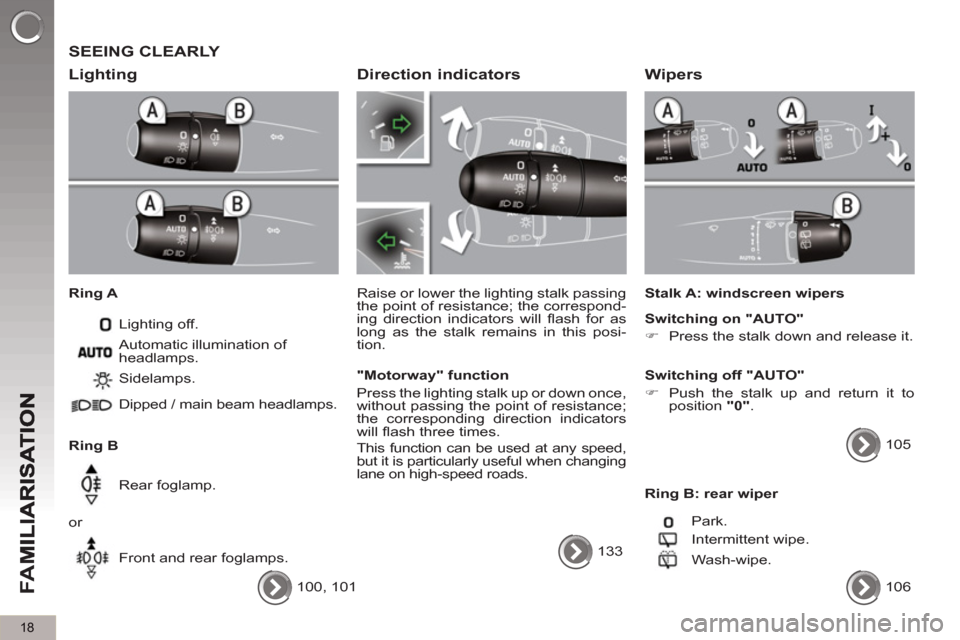
18
FA
M
SEEING CLEARLY
Li
ghting
Ring A
Lighting off.
Ring B Sidelamps.
Dipped / main beam headlamps.
Rear foglamp.
or
Front and rear foglamps. Automatic illumination of
headlamps.
100, 101
Direction indicators
Raise or lower the lighting stalk passing
the point of resistance; the correspond-
ing direction indicators will fl ash for as
long as the stalk remains in this posi-
tion.
"Motorway" function
Press the lighting stalk up or down once,
without passing the point of resistance;
the corresponding direction indicators
will fl ash three times.
This function can be used at any speed,
but it is particularly useful when changing
lane on high-speed roads.
133
Wipers
Stalk A: windscreen wipers
Switching on "AUTO"
�)
Press the stalk down and release it.
Switching off "AUTO"
�)
Push the stalk up and return it to
position "0"
.
105
Ring B: rear wiper
Park.
Intermittent wipe.
Wash-wipe.
106
Page 41 of 284
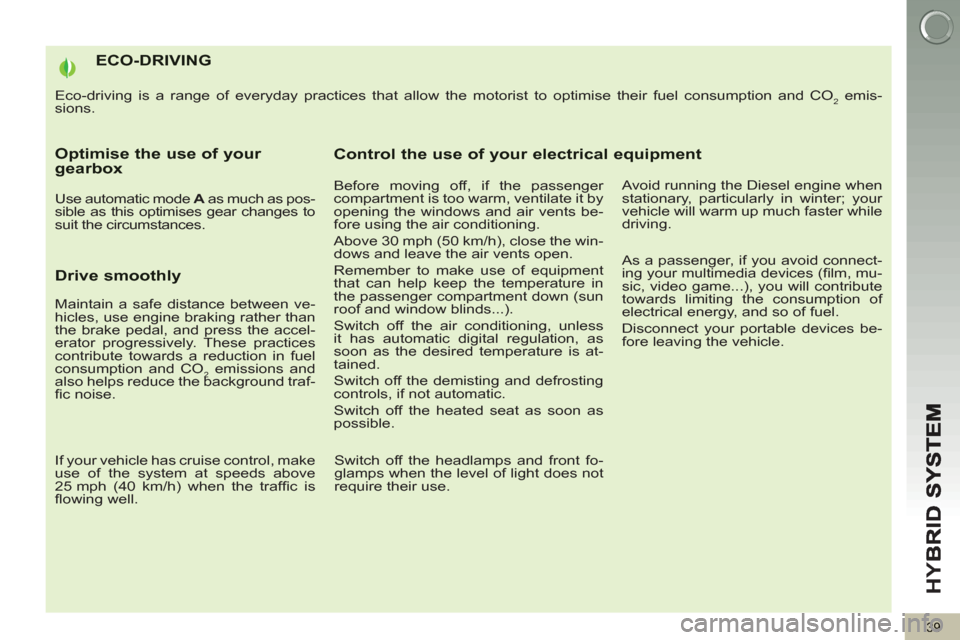
HY
B
39
ECO-DRIVING
Eco-driving is a range of everyday practices that allow the motorist to optimise their fuel consumption and CO2 emis-
sions.
Optimise the use of your gearbox
Use automatic mode A
as much as pos-
sible as this optimises gear changes to
suit the circumstances.
Drive smoothly
If your vehicle has cruise control, make
use of the system at speeds above
25 mph (40 km/h) when the traffi c is
fl owing well.
Control the use of your electrical equipment
Before moving off, if the passenger
compartment is too warm, ventilate it by
opening the windows and air vents be-
fore using the air conditioning.
Above 30 mph (50 km/h), close the win-
dows and leave the air vents open.
Remember to make use of equipment
that can help keep the temperature in
the passenger compartment down (sun
roof and window blinds...).
Switch off the air conditioning, unless
it has automatic digital regulation, as
soon as the desired temperature is at-
tained.
Switch off the demisting and defrosting
controls, if not automatic.
Switch off the heated seat as soon as
possible.
Switch off the headlamps and front fo-
glamps when the level of light does not
require their use.
Avoid running the Diesel engine when
stationary, particularly in winter; your
vehicle will warm up much faster while
driving.
As a passenger, if you avoid connect-
ing your multimedia devices (fi lm, mu-
sic, video game...), you will contribute
towards limiting the consumption of
electrical energy, and so of fuel.
Disconnect your portable devices be-
fore leaving the vehicle.
Maintain a safe distance between ve-
hicles, use engine braking rather than
the brake pedal, and press the accel-
erator progressively. These practices
contribute towards a reduction in fuel
consumption and CO
2 emissions and
also helps reduce the background traf-
fi c noise.
Page 51 of 284
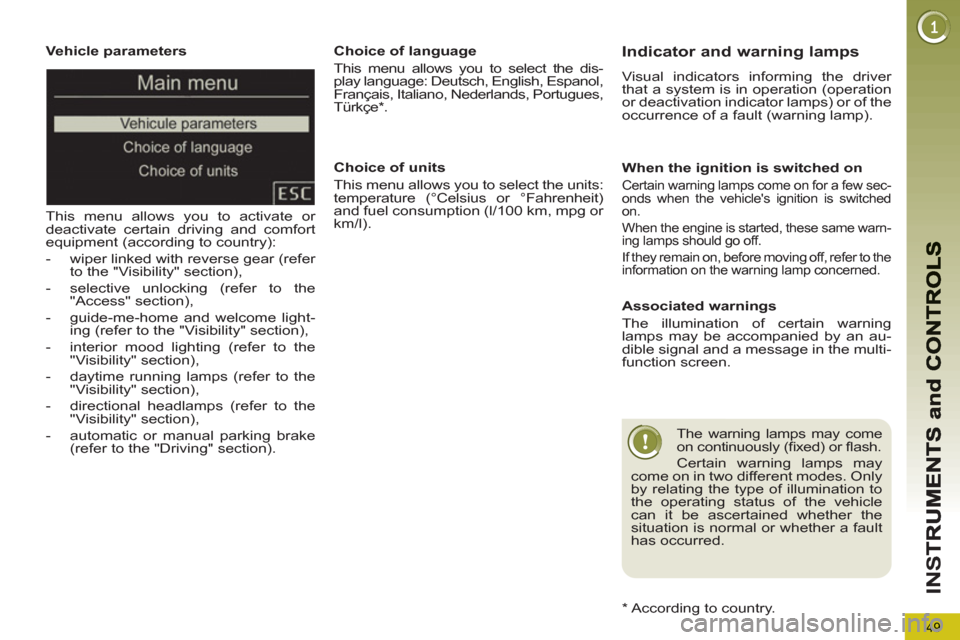
49
IN
S
Vehicle parameters
This menu allows you to activate or
deactivate certain driving and comfort
equipment (according to country):
- wiper linked with reverse gear (refer
to the "Visibility" section),
- selective unlocking (refer to the
"Access" section),
- guide-me-home and welcome light-
ing (refer to the "Visibility" section),
- interior mood lighting (refer to the
"Visibility" section),
- daytime running lamps (refer to the
"Visibility" section),
- directional headlamps (refer to the
"Visibility" section),
- automatic or manual parking brake
(refer to the "Driving" section).
Choice of units
This menu allows you to select the units:
temperature (°Celsius or °Fahrenheit)
and fuel consumption (l/100 km, mpg or
km/l).
Choice of language
This menu allows you to select the dis-
play language: Deutsch, English, Espanol,
Français, Italiano, Nederlands, Portugues,
Türkçe * .
*
According to country. Indicator and warning lamps
Visual indicators informing the driver
that a system is in operation (operation
or deactivation indicator lamps) or of the
occurrence of a fault (warning lamp).
When the ignition is switched on
Certain warning lamps come on for a few sec-
onds when the vehicle's ignition is switched
on.
When the engine is started, these same warn-
ing lamps should go off.
If they remain on, before moving off, refer to the
information on the warning lamp concerned.
Associated warnings
The illumination of certain warning
lamps may be accompanied by an au-
dible signal and a message in the multi-
function screen.
The warning lamps may come
on continuously (fi xed) or fl ash.
Certain warning lamps may
come on in two different modes. Only
by relating the type of illumination to
the operating status of the vehicle
can it be ascertained whether the
situation is normal or whether a fault
has occurred.
Page 52 of 284
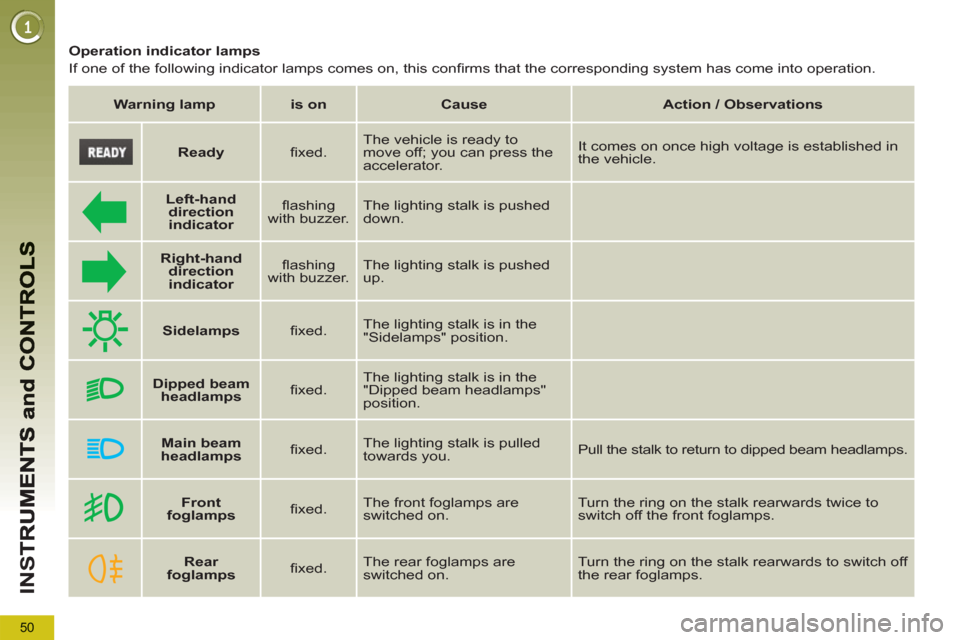
50
IN
S
Operation indicator lamps
If one of the following indicator lamps comes on, this confi rms that the corresponding system has come into operation.
Warning lamp
is on
Cause
Action / Observations
Left-hand
direction
indicato
r
fl ashing
with buzzer. The lighting stalk is pushed
down.
Right-hand
direction
indicator
fl ashing
with buzzer. The lighting stalk is pushed
up.
Sidelamps
fi xed. The lighting stalk is in the
"Sidelamps" position.
Dipped beam
headlamps
fi xed. The lighting stalk is in the
"Dipped beam headlamps"
position.
Main beam
headlamps
fi xed. The lighting stalk is pulled
towards you. Pull the stalk to return to dipped beam headlamps.
Ready
fi xed. The vehicle is ready to
move off; you can press the
accelerator. It comes on once high voltage is established in
the vehicle.
Front
foglamps
fi xed. The front foglamps are
switched on. Turn the ring on the stalk rearwards twice to
switch off the front foglamps.
Rear
foglamps
fi xed. The rear foglamps are
switched on. Turn the ring on the stalk rearwards to switch off
the rear foglamps.
Page 65 of 284
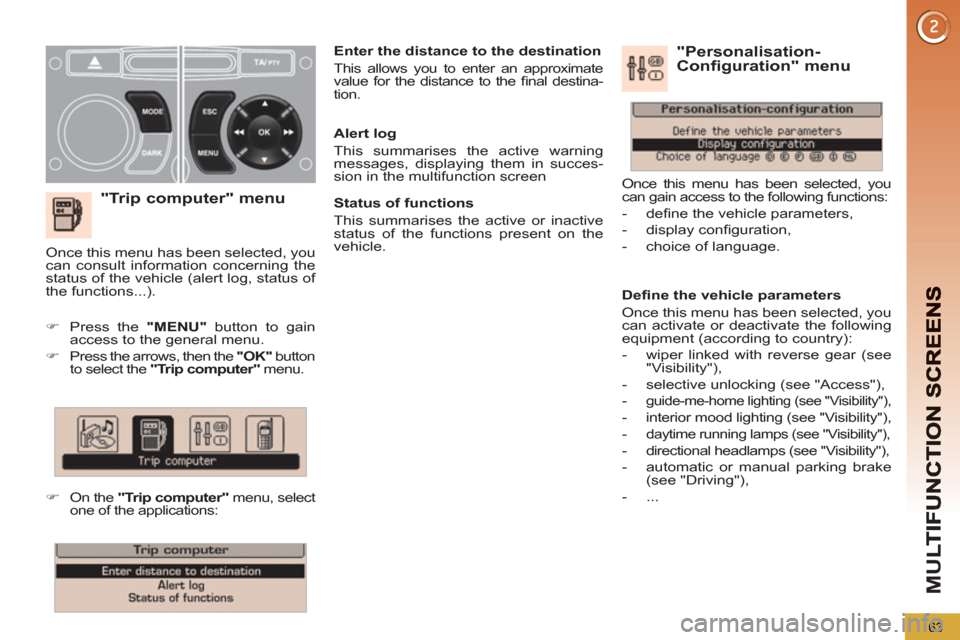
M
U
63
"Trip computer" menu
�)
Press the "MENU"
button to gain
access to the general menu.
�)
Press the arrows, then the "OK"
button
to select the "Trip computer"
menu.
�)
On the "Trip computer"
menu, select
one of the applications:
Enter the distance to the destination
This allows you to enter an approximate
value for the distance to the fi nal destina-
tion.
Once this menu has been selected, you
can consult information concerning the
status of the vehicle (alert log, status of
the functions...).
Defi ne the vehicle parameters
Once this menu has been selected, you
can activate or deactivate the following
equipment (according to country):
- wiper linked with reverse gear (see
"Visibility"),
- selective unlocking (see "Access"),
-
guide-me-home lighting (see "Visibility"),
- interior mood lighting (see "Visibility"),
-
daytime running lamps (see "Visibility"),
- directional headlamps (see "Visibility"),
- automatic or manual parking brake
(see "Driving"),
- ...
"Personalisation-
Configuration" menu
Once this menu has been selected, you
can gain access to the following functions:
- defi ne the vehicle parameters,
- display confi guration,
- choice of language.
Alert log
This summarises the active warning
messages, displaying them in succes-
sion in the multifunction screen
Status of functions
This summarises the active or inactive
status of the functions present on the
vehicle.